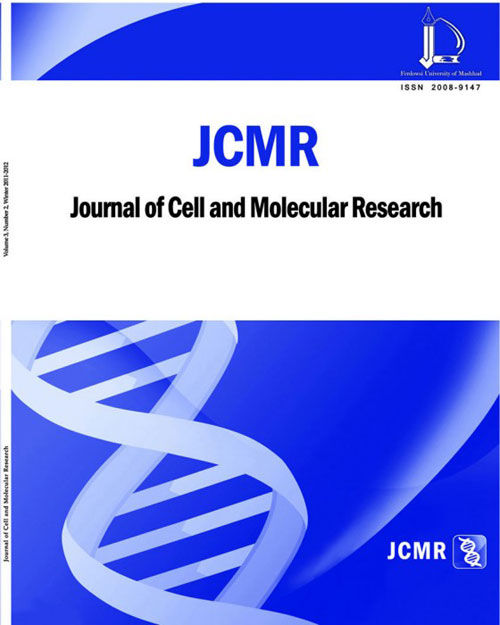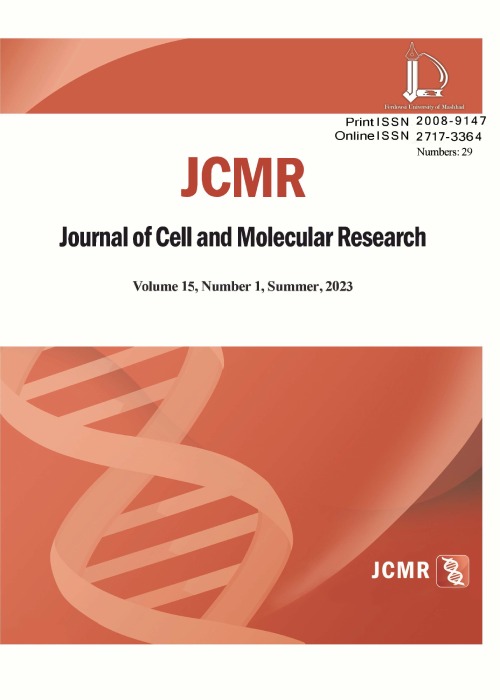فهرست مطالب

Journal of Cell and Molecular Research
Volume:7 Issue: 1, Summer and Autumn 2015
- تاریخ انتشار: 1394/05/12
- تعداد عناوین: 10
-
-
Pages 1-2Wound care management is a continuous challenging task for researchers and tissue engineers. Skin substitutes (synthetic and natural) have been introduced as emergency replacements/grafts to the damaged skin and a number of problems such as infection, graft rejection, inadequate healing, short shelf life etc. have reduced their clinical importance as being the ideal skin substitutes. A number of novel ideas have been presented in last decades which have focused on the applications of stem cells as ideal candidate in the development of ideal skin substitutes.Keywords: Cell therapy, stem cell therapy, wound healing, wound management
-
Pages 3-10There exists an association between PI3K pathway licentious activity and the considerable feature of high metastatic potential of the genitourinary cancer cells. Although DU 145 and 5637 have functional phosphatase and tensin homolog (PTEN) tumor suppressor gene, which antagonizes PI3K function, PC-3 is null for PTEN gene. In pursuit to explain why PTEN bearing cell lines display high metastatic behavior, we searched for any discrepancy in PI3K isoforms expression pattern between these cell lines. Gathering gene bank data files, specific primers were designed, for all the genes of 12 studied isoforms from 3 different classes of PI3K. Total RNA was extracted and examined by Real- Time PCR to compare the cells for the type and amount of the isoforms which expressed. Cα and R2 isoforms are indicative of an equal expression for PC3 and DU145, R3 transcripts revealed 80% decrease in DU145 and Cβ, R1 and C2α demonstrated an increased expression in DU145. When a comparison is made between 5637 and PC3, it can be seen that although a little decrease in the level of R3 transcripts was demonstrated, the amount of Cα, Cβ, R2, R1 and C2α increased. In conclusion in this study it is proposed that R1, R2, Cα, Cβ, C2α and R1, Cβ, C2α are candidate genes for silencing via RNAi in 5637 and DU145, respectively, to evaluate their roles in metastatic behavior of the both studied PTEN bearing cell lines.Keywords: PI3K Isoforms, Prostate, Bladder, 5637, DU145, PC3
-
Pages 11-18Newcastle is a significant avian disease continuing to cause considerable loss. Developments in genetic engineering have led to plant-based platforms for human and animal vaccine production. Recombinant vaccine production in hairy root systems have several advantages over stable expression in whole plants, including high growth rates, ready genetic manipulations, high levels of recombinant protein production, and the potential for bioreactor culture. In an attempt to develop a recombinant vaccine in hairy roots, the sequences encoding fusion (F) and haemagglutinin-neuraminidase (HN) epitopes of Newcastle disease virus were cloned in pBI121 expression vector which was then transferred into leaf disks of tobacco (Nicotiana tabaccum) ''Turkish'' cultivar by means of Agrobacterium rhizogenes. Hairy roots developed on MS medium containing 50 mg/L kanamycin and 30 mg/L meropenem. Incorporation of the heterologous gene in the genome of hairy roots was confirmed by PCR. Expression analyses were performed by real-time PCR at transcription level and by dot-blot and ELISA assays at translation level, all confirming the expression of the heterologous gene and production of the recombinant protein.Keywords: Recombinant Vaccine, Antigen Expression, Newcastle Disease, Hairy Roots, Agrobacterium Rhizogenes
-
Pages 19-25Congenital factor XIII deficiency is a very rare bleeding disorder, but because of the high rate of consanguineous marriages, it is common in Sistan and Baluchestan Province of Iran. The discovery of promoter hypermethylation of numerous miRNAs in human diseases has demonstrated an epigenetic mechanism for aberrant miRNA expression. The present study has analyzed methylation and expression status of miR-185 and miR-132 genes in patients with inherited factor XIII deficiency in a sample of South-Eastern Iranian population. Promoter methylation of miR-185 and miR-132 was investigated by Methylation Specific Polymerase Chain Reaction (MS PCR) in blood samples of 75 factor XIII deficient individuals and 74 healthy controls. Expression level of these genes was also assessed in 15 blood samples of patients and 15 healthy controls using real-time quantitative reverse transcription PCR. Analysis of miR-132 and miR-185 promoter hypermethylation did not show any significant difference between cases and controls. Relative gene expression analysis in cases (n=15) with congenital factor XIII deficiency and healthy controls (n=15) revealed no statistically significant relationship for miR-132 (p = 0.126) and miR-185 (p = 0.165) genes. Our findings indicated that promoter methylation as well as gene expression of miR-132 and miR-185 had no significant effect on etiology of factor XIII deficiency.Keywords: XIII Deficiency, MicroRNAs, MiR, 185, MiR, 132, DNA Methylation
-
Pages 26-31Long non-coding RNAs (lncRNAs) have recently found to have important regulatory roles, and their aberrant expressions and functions are directly linked to carcinogenesis. Both urinary bladder and breast tumors are prevalent neoplasms, with high rates of incidence. To identify a potential expression alteration of the recently discovered «anti-differentiation non-coding RNA, (ANCR), during tumorigenesis, we initially assessed its expression in several cancer cell lines (LNCAP, MCF-7, Ht-29, 5637, A549, HepG2, and PC3) and then compared its expression variability in tumor vs. non-tumor samples of bladder and breast. Here, ANCR expression profile was studied by qRT-PCR in paired tumor and marginal non-tumor samples obtained from patients that had been referred to the Labbafi-Nejad and Imam Khomeini Hospitals, respectively. Our data revealed a significant upregulation (p = 0. 003) of ANCR in breast tumor tissues, in comparison to non-tumor marginal specimens from same patients. Similar upregulation was also detected in bladder tumor samples, however, this alteration was not statistically significant (p ≥ 0. 05), probably due to small number of samples (n = 10). In conclusion, our results suggest a possible role of ANCR in tumorigenesis of bladder and breast tissues, as well as its potential usefulness as a novel diagnostic biomarker for bladder and breast tumors.Keywords: lncRNA, ANCR, Breast Cancer, Bladder Cancer
-
Pages 32-37Stroke is the leading cause of death and disability in the world after the cancer and cardiovascular diseases. Genetic factors have main significance to got stroke. Renin-angiotensin system contains candidate genes and polymorphisms for causing stroke. There are reported associations between stroke and angiotensin II type-1 receptor g. 1166A > C polymorphism (rs5186). Therefore in this study this association was investigated for the east Iranian population. This study is based on 201 stroke patients and 220 controls. To predict the genetic risk of stroke allele and genotype frequencies of angiotensin II type-1 receptor rs5186 were analyzed in this population according to stroke subtypes, gender, age, hypertension, diabetes mellitus, high and low density lipoprotein and triglycerides. According to statistical analysis no significant difference was found between case and control groups. But there were a significant relevance between total cholesterol and stroke (p = 0.037). In this population angiotensin II type-1 receptor g. 1166A > C polymorphism did not increase the risk of stroke. The main reason for this study is complex nature of gene-environment interactions in the pathophysiology of this disease.Keywords: Stroke_Polymerase Chain Reaction_Restriction Fragment Length Polymorphism (PCR_RFLP)_Angiotensin II type_1 Receptor g. 1166A > C Polymorphism
-
Pages 38-46Cadmium, a metal widely used in industrial processes, has been recognized to be a highly toxic and dangerous environmental pollutant. Random amplified polymorphic DNA (RAPD) test is a feasible method to evaluate the toxicity of environmental pollutants on vegetal organisms. Herein, two Iranian ecotypes of Cuminum cyminum (cumin) plantlets following exposure to cadmium (Cd) concentrations of 300–1050 µM for 7 days were screened for DNA genetic alterations by DNA fingerprinting. 10 RAPD primers of 50–70% GC content were found to produce unique polymorphic band profiles on treating cumin seedlings. After Cd treatment, significant changes were observed in RAPD profiles of both ecotypes. These changes included variation in band intensity, disappearance of bands, and appearance of new PCR products in comparison to the control group, and they were dose dependent. These results indicated that genomic template stability (GTS, a qualitative measure reflecting changes in RAPD profiles) was significantly affected at the above Cd concentrations. The GTS index in both ecotypes gradually decreased with an increase in Cd concentrations. These findings suggest that DNA polymorphism detected by RAPD analysis could be a powerful eco-toxicological tool to evaluate the genotoxic effects of cadmium on plants.Keywords: Cadmium (Cd), Genomic Template Stability, RAPD, Genotoxicity, Cuminum cyminum
-
Pages 47-52Administering growth hormone increases growth rate of cultured fish. The aim of this study was isolation and synthesize of Persian sturgeon GH cDNA. The total RNA was extracted from pituitary gland of Persian sturgeon and cDNA was synthesized. The full-length cDNA sequence of Persian sturgeon contains a 645 nucleotide open reading frame, which encoding a 214 amino acid residues. The position of the signal peptide cleavage site was predicted to be at position 72. After cleaving of a signal peptide of 24 amino acid resi dues, a mature peptide of 190 aa formed. The blast observed that the PS pre GH have highest nucleotide sequence similarity with Acipenseridae family and mammals GH. Secondary structure and tertiary structure of Persian sturgeon growth hormone gene were prediction by online software. The secondary structure of the GH was revealed the predomination of a- helix (> 55%), the domains of high conservation across the vertebrate GH protein. The predicted 3D structure of Persian sturgeon growth hormone attribute to the typical 4-a-helix bundle protein conformation, the characteristic 3-D confirmation of growth hormones.Keywords: Persian sturgeon, growth hormone, cDNA
-
Pages 53-58Amorpha-4,11-diene synthase (ADS) is a key enzyme in biochemical pathway of the antimalarial agent artemisinin. An Agrobacterium-mediated transformation was carried out to express a synthetic ADS gene in green microalga Chlamydomonas reinhardtii strain 125C with bacterial strains GV3101 and LBA4404. The foreign gene was optimized based on codon usage bias of the microalga. Integration of the ADS in nuclear genome of C. reinhardtii was confirmed by polymerase chain reaction assay. The transgenic colonies cultured on selective medium turned yellow after three days and gradually died. Transformation procedure, growth habit of the transgenic microalgae together with probable causes of transformants loss is discussed. The present study is the first investigation for production of ADS enzyme in a microalgal system.Keywords: Amorpha, 4, 11, diene synthase, Chlamydomonas reinhardtii, Agrobacterium, Transformation
-
Pages 59-67Green plants have emerged as ideal platforms for production of recombinant vaccine during recent decades. Various antigens relating to a large number of animal and human diseases have been studied in different plant species for production of recombinant vaccines. Despite the unique advantages of plant systems as green factories for production of recombinant vaccines, there are some major hurdles that have prevented commercial production of plant-based vaccines. In this review, theoretical background and practical applications of plant system for production of various recombinant vaccines are discussed.Keywords: Recombinant vaccine, plant, genetic transformation


